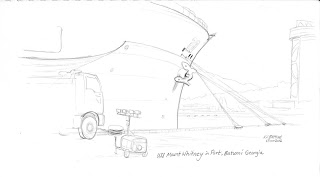How joyous it is when a project comes to fruition-- especially when it's been a long, intense process involving every bit of your creativity and skills.
Sculpture can be challenging. It is difficult to create something from materials such as clay or wax, and to make it look as you want it to look. To capture the emotions, form and texture of a thing in three dimensions requires hard work, focus, and faithfulness. But with bronze casting, THAT'S ONLY HALF OF THE STORY.
It takes a whole, involved creative process to take the original sculpture, formed by the artist in clay, and cast it in a metal.
Foundry work is the big unsung element of sculpture. So much work is done by the foundry craftsmen, yet the artist gets all the credit!
A couple of years ago I was blessed to have one of my sculptures cast in bronze for display by the National Museum of the Marine Corps in Quantico.
I had begun the work several years before that, and posted about it on this blog,
here and
here (at the bottom of the post).
Well, the sculpture was brought to a pretty high level of finish when I was on active duty, but due to an early end to my active duty career (I'd been a mobilized Reservist on active duty for eight years, and could no longer stay on active duty in the combat artist billet according to law and regulation), the sculpture sat in the Combat Art Collection gathering dust, hoping for finish and fulfillment.
A few months ago, the National Museum of the Marine Corps contacted me and asked if I'd be willing to finish the mule sculpture for them, and to assist the foundry to get it molded and cast in bronze, for display at the Museum! I said "yes" of course! So a few dozen hours of sculpting later, and another several weeks of good, hard foundry work at Wegner Metal Arts in Fredericksburg, VA, the sculpture was finally realized in bronze!
Here are some of the photos of the process:
The original, finished in wax, metal, wood, and plaster, arrives at the foundry:
The original is segmented out into its constituent parts, for the next step in the process:
Rubber Molding: (I call this the "chocolate bunny" phase, because the resulting cast wax model is a lot like a hollow chocolate bunny...!):
(the nylon strings I'd used had to be replaced with twine, in order to not leave a residue and cause trouble during the lost wax "burn out" phase...
CASTING IN BRONZE!
The wax model is dipped in a liquid ceramic "slip" and coated in silica, several times, until a shell is around the model. Then, this shell is heated to harden the mold and melt out the wax, leaving an empty mold in the exact shape of the wax model which once occupied it.
Then, the mold is heated once more and molten wax is then poured in, creating an exact replica in bronze of the wax model, and thus the original piece.
Steven and Stewart Wegner of Wegner Metal Arts in Fredericksburg, VA pour the bronze into the ceramic molds.


.jpg)
.jpg)

.jpg)










.jpg)
.jpg)
.jpg)










































